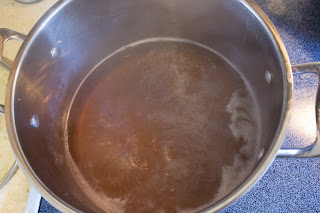 |
| This shows how much DME I need for my yeast stater. (via YeastCalac) |
What is a yeast starter you say? Well, let me explain in a mini beer lesson...
When you make beer, basically you are making a big batch of "flavored sugar water" (wort). When you add yeast to that sugar water, the yeast cells eat the sugar and ferment it into CO2 and alcohol. The CO2 is released via the air lock and the alcohol stays in the beer. That was fun right?
Back to why a yeast starter is good...
If you don't have viable yeast cells, they wont eat the sugar. In turn, the wort won't ferment. Making a yeast starter makes sure that there are enough viable yeast cells to chomp down on all those yummy sugars.
 Making a yeast starter is very simple and can be done within an hour (at most). The photo shows the things you will need.
Making a yeast starter is very simple and can be done within an hour (at most). The photo shows the things you will need.Adding water to the pot. Bring this to a boil then add the dried malt extract.
While waiting for the water to come to a boil, I make sure to sanitize anything that is going to touch the final product. Cleaning and sanitization is key when doing anything brewing related.
I found that the sweet spot for boil time is about fifteen minutes. Some people boil for a half hour. That's too long for me. I lose too much wort during the boil off and fifteen minutes still does the job just fine!
For this starter, I'm using Wyeast 1056. It's a basic ale yeast that can be used for a wide variety of styles of beers. IPAs, Pale Ales, etc.
After the fifteen minute boil is done, the wort goes back into the glass and needs to be cooled down to room temperature before we can add the yeast. If you add the yeast to wort that is too hot, it kills all the yeast cells. Not good!
I use the very scientific method of a sink full of cold water and ice to bring the wort temperature down.
Here is the yeast being added to the cooled wort.
After everything is done, it's time to put the starter on the stir-plate.
A stir-plate is basically a box with a magnetic computer fan in it. In with the starter is a one inch stir bar that the fan spins magnetically inside the jar so it keeps the yeast cells always in suspension.
To my absolute amazement, this starter started fermenting within an hour (I've never seen that before).
I will let this run for about 36 hours then pour some off to harvest yeast (I'll make another blog post about this) and stick the remaining in the refrigerator until brew day!











No comments:
Post a Comment